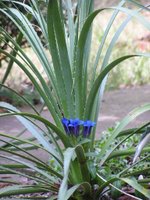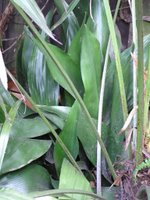
If you've a Mediterranean style garden, and you're looking for a plant that's a little bit different, then give Dasylirion Wheeleri a try.
It's been five years or so since I bought my plant and and it's turned out to be an excellent addition to the garden.
I've been so impressed with this plant, that, along with D.Texanum, I've grown more of them from seed.
Native to the South Western States of the U.S.A. and Mexico, Dasylirion Wheeleri, is one of those plants that has proved to be very useful to man.
It's been used for everything, from cattle feed to making baskets and the brewing of some fearsome sounding liquor called "Sotol", even the dried flower stems have been used as fence poles and for roofing.
D.Wheeleri, is another one of those "Looks like a pineapple top plants" only the leaves, rather than being short stubby things are very slender and anything up to four feet long.
They curve back very gracefully giving the whole plant a symmetrical look, they're also armed with a row of vicious spines along the leaf edges.
The leaf tips are peculiar, they tend to go brown and curl around in the shape of a piglets tail.
This doesn't mean there's something wrong with the plant, it's just something it does naturaly.
In nature, Dasylirion grow on sunny well drained hillsides both on Limestone and Granite formations.
They're not fussy about soil type, but excellent drainage is a must.
Mine grows in a sunny, well drained, south facing scree bed and since I planted it out some four years ago, it's stood temperatures down to -10c. without any protection.
Dasylirion, are best planted out in Spring, when all danger of frost has gone.
Water well until the plant is well established, don't use high nitrogen fertilizer, as this can lead to top growth at the expense of roots and it's root growth you need initially.
Once established, it's up to you how you look after it.
So, you can either leave it to nature and let it grow at its own pace, or you can speed things up a bit, by watering well during dry periods and feeding with high nitrogen fertilizer. Posted by: Mike.
These though are plants which need room, give them some space.
One word of warning, think twice about growing them if you have young children or boisterous pets, the spines can inflict a good deal of damage to little fingers.

If there's one plant which is synonymous with the Victorian era, then it must be Aspidistra Elatior.
At the height of its popularity, it was said that virtually every house in the land had one of these growing somewhere in a room or hallway.
At the end of the era, the growing of exotic plants including A.Elatior went into a swift decline, to be remembered only in a few books written at the time.
During the 1980's, renewed interest in growing palms and other exotics saw A.Elatior making something of a comeback, this time though, as a garden plant not a house plant.
By coincidence, the late 70's and 80's also saw our old chums the botanists renewing their interest in Aspidistra and this has resulted in many more species being found and described.
So, from the original 8 or 10 species, there are now some 50 plus, with it is believed, yet more to be discovered.
Several of these new discoveries, have been introduced into cultivation and some are proving to be hardy when grown in the garden, A.Elatior however, is still the easiest to find and it's the one I concentrate on in this blog.
Aspidistra are woodland plants originating in the far east.
China it seems, has the most species, with Japan and Vietnam also being home to some fine plants.
At the moment, I only grow A.Elatior and A.e."Variegata", there's also one I've seen called A.e."Milky Way" and this too should make a good garden plant, but I've yet to try it.
A.Elatior, is famed for its ability to grow in less than perfect situations and it certainly does tolerate neglect.
Unfortunately, that's all it does, it tolerate's but it doesn't thrive.
With a modicum of care and attention, you can have a plant that thrive's, prospers and is a credit to your plant growing skills.
Although Aspidistra will grow in deep shade, it seems a shame to plant it where it's likely to go unnoticed.
Far more preferable, is to plant it in light to medium shade in a spot where it can be appreciated.
Avoid planting it in the sun, as this can cause bleaching of the leaves, making them look rather tatty.
Neither A.Elatior or A.e."Variegata" are fussy about soil type, but it must be well drained, dry to moist is preferable, avoid any area with standing water or poor drainage as this is likely to kill your plant. ( As I found to my cost. )
A well cultivated soil is best, dig in plenty of well rotted manure into the planting area and add some fish, blood and bone fertilizer.
The best time for planting out, is early Spring when all danger of frost has gone.
Keep the plant well watered until it's established and then you can leave it to its own devices.
Aspidistra, aren't exactly the greyhounds of the plant world and growth tends to be slow.
Supplementary watering and feeding with weak general purpose fertilizer will speed things up a tad and certainly give you a better looking plant, in fact, a plant to be proud of.
Propagation is by division and this is best done in early Spring.
The process is easy, simply lift the plant and carefully divide it into as many pieces as you need.
Try not to cut tiny bits off, make them a reasonable size.
Remove any excess soil and dead roots, dust all cuts with Sulpher powder.
I pot mine up in a mixture of coir, plenty of Perlite and soilless compost and I add some long life fertilizer pellets.
Keep the pots in a shaded spot until plants are established.
Don't get the compost soaking wet, this is the kiss of death for Aspidiatra, just keep them moist and let them dry out a tad between watering. Posted by: Mike.
Comment: There are some people who find A.Elatior boring.
What poor misguided souls they are, no taste.
I think, it's one of the best plants for the open garden, being easy to grow and maintain.
Add a dash of T.L.C. and you've got a plant that will be the envy of your friends.




